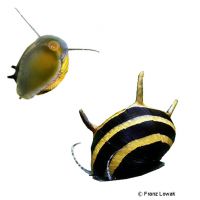Horned Nerite Black & Gold (Clithon corona)
| Horned Nerite Black & Gold Clithon corona | |
|---|---|
| Name | Horned Nerite Black & Gold |
| Name Lat. | Clithon corona |
| Family | Nerites |
| Family lat. | Neritidae |
| Order | Cycloneritids |
| Order lat. | Cycloneritida |
| Origin | Southeast Asia |
| Habitat | Streams, estuaries |
| Diet | Algae, detritus |
| pH | 7.0-8.5 |
| Behavior | Peaceful |
| Keeping | Group |
| Care Level | Easy |
| Reproduction | Oviparous |
| Breeding | None reported |
| Life Span | 6-8 years |
| Protection | No |
| Metric Units | |
| Size | 2 cm |
| Temperature | 20-27 °C |
| Hardness | 10-20 °dH |
| Aquarium | ~ 20 l |
| US Units | |
| Size | 0.8" |
| Temperature | 68-81 °F |
| Hardness | 178-356 ppm |
| Aquarium | ~ 5 gal |
Distribution and habitat
The staghorn snail "Black & Gold" is a color form. Staghorn snails are widely distributed from southern China through Japan, the Philippines and New Guinea to Samoa. There they live in coastal streams, estuaries, brackish pools and mangrove swamps
Maintenance
They need a well-structured aquarium with roots, stones and plants. The substrate of dark sand or gravel should be partially covered with foliage (e.g. sea almond leaves, oak leaves), decaying plant material and mulm. Medium to hard water is ideal.
Water quality must be that required for average freshwater fish keeping. No ammonia, ammonium or nitrite should be detectable in the water and the nitrate value should be below 100 mg/l. When using a filter, make sure that only a weak current is created and that no animals can be sucked in. The lighting must correspond to the natural day-night rhythm of the animals.
Diet
They feed mainly on algae growth, but also ingest detritus, plant food and carrion. In the aquarium they rasp algae from plants and furnishings. As a supplement and in case of algae deficiency, algae leaves, scalded lettuce or dry food (flakes, food tablets) with high vegetable content (spirulina) can also be offered, which is usually accepted after habituation.
Feeding should be varied to prevent the occurrence of deficiency symptoms. Unaccepted food must be removed after 2-3 hours.
Behaviour and compatibility
They should be kept in a group of 5-10 staghorn snails. Socialization with fish and other invertebrates that do not consider these small snails as food is well possible
Basically, only mutually compatible species with similar requirements for water conditions and water temperature should be socialized.
Reproduction and breeding
They are separately sexed. The sexes can hardly be distinguished from each other externally. The sexual organ of the male is located under the right antenna, but is usually not visible because of the close-fitting shell.
After mating, the female sticks egg capsules to various substrates. Each of these capsules contains numerous eggs from which swimmable larvae hatch and live for some time as part of the marine plankton in the sea. As they grow, they then form their shells, switch to a crawling lifestyle, and return to the estuaries. There are no known reports of successful breeding in the aquarium.
Important
They are excellent algae eaters and are particularly well suited for algae control. Feeding damage to plants does not occur. The different Clithon species with their numerous color forms are very difficult to distinguish. Also, pattern and color can change with the water.
To build up their shell they need a sufficient supply of lime. Especially in soft, acidic water, shell damage (holes) can occur due to lack of lime, which can lead to the death of the snail. Therefore, special attention should be paid to the calcium concentration in the water and, if necessary, calcium should be added in the form of limestone, cuttlebone or special preparations from the specialized trade
The foliage (sea almond tree, oak, beech, etc.) not only provides cover, but when rotting promotes the development of microorganisms, which are a valuable secondary food source.
The well-being of the animals should be monitored regularly. Temperature should be checked daily, pH, hardness and nitrate levels at least every 14 days. Regular partial water changes are recommended, even when contaminant levels have not yet reached the upper limit. Sudden changes in water quality should be avoided. Newly introduced animals must be accustomed slowly to the water in the aquarium.
Further literature can be found in your pet store.
References
Text: petdata; Image: Franz Lowak
Source: BITTER (2008), Schnecken-Fibel, Dähne Verlag; ENGELMANN & LANGE (2011): Zootierhaltung - Tiere in menschlicher Obhut: Wirbellose, Verlag Harri Deutsch
